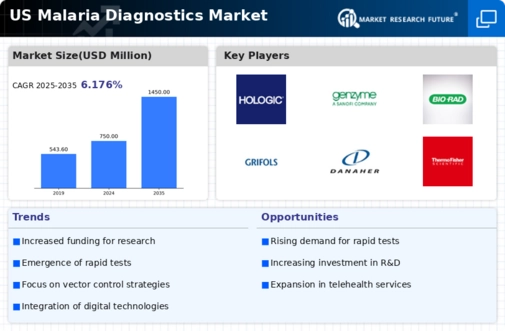The US Malaria Diagnostics Market has been witnessing significant developments driven by increasing awareness about malaria's prevalence and the necessity for timely diagnosis and treatment. The market is characterized by the presence of various players, each striving to innovate and improve diagnostic accuracy. Factors such as advancements in technology, regulatory approvals for rapid diagnostic tests, and the integration of artificial intelligence in diagnostic processes have revolutionized the landscape. Competitive insights in this market reveal a dynamic interaction among established companies, promising start-ups, and research institutions, all aiming to enhance diagnostic capabilities and address the evolving needs of healthcare providers.
The need for effective malaria diagnostics has intensified due to the ongoing efforts to eliminate malaria in specific regions, creating a conducive environment for market players to thrive.
Hologic has carved a unique niche within the US Malaria Diagnostics Market through its commitment to advancing women's health and infectious disease diagnostics. The company leverages innovative technologies to develop state-of-the-art diagnostic solutions that ensure accurate and rapid results. Hologic's strengths lie in its extensive research and development capabilities, allowing it to stay at the forefront of diagnostic innovation. The company's expertise in molecular diagnostics and its comprehensive portfolio help it maintain a competitive edge in this market.
Hologic's strategic focus on partnerships with healthcare providers and its presence in various diagnostic platforms underscore its commitment to enhancing malaria diagnostic capabilities in the United States. The company’s commitment to quality and accuracy has positioned it as a trusted player among healthcare professionals, contributing significantly to the overall efficiency of malaria management within the US.
Genzyme operates within the US Malaria Diagnostics Market, where it is recognized for its robust portfolio of diagnostic solutions tailored to the needs of clinicians and laboratories. The company emphasizes the development of high-quality tests that provide reliable results for effective malaria management. Genzyme stands out due to its strong market presence, bolstered by its strategic acquisitions that have expanded its capabilities and breadth in diagnostics. The company focuses on delivering a range of diagnostic products, including rapid tests and laboratory-based solutions. Its strengths lie in advanced technological integration and a strong commitment to research and development.
Genzyme is also committed to enhancing healthcare access through collaborations with local health authorities and organizations to combat malaria effectively. The company's proactive approach in addressing market demands, along with its continuous efforts to innovate, ensures its significant impact on malaria diagnostics in the US, positioning it as a key player in tackling this pressing public health issue.





















